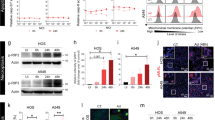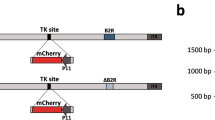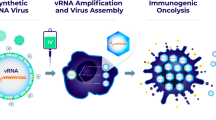Abstract
replicating viruses for cancer gene therapy have beneficial antitumor effects, however, in the setting of an enzyme/prodrug system, the interactions between these viruses and the activated agents are complex. a replicating vaccinia virus expressing the cytosine deaminase gene (vvcd), which converts the prodrug 5-fc into 5-fu, was characterized in vitro and in vivo for its antitumor effects and pathogenicity. replicating vvcd (±5-fc) at various mois was used to infect mc38 murine colon adenocarcinoma cells. at high mois (>0.1) virus alone was able to kill the majority (65–90%) of cells by day 5 with no additional benefit from prodrug. At low MOIs only the effect of prodrug is seen. Cell lysates demonstrated 300-fold reduced viral recovery from cells treated with both VVCD and 5-FC compared with controls treated with virus alone. Nude mice bearing subcutaneous MC38 tumors were injected with VVCD (or control) and treated with 5FC or control. Mice injected with VVCD (with or without 5FC treatment) had smaller tumors than the controls, suggesting that replicating vaccinia alone is cytotoxic to tumors in vivo. The addition of 5-FC improved the antitumor response when a low dose of virus was injected into tumors. Also, compared with mice that received virus alone, those that received VVCD and 5FC had significantly prolonged survival from virus-mediated death. In conclusion, the addition of an enzyme/prodrug system to a replicating virus can improve the antitumor response and decrease viral pathogenicity.
This is a preview of subscription content, access via your institution
Access options
Subscribe to this journal
Receive 12 print issues and online access
$259.00 per year
only $21.58 per issue
Buy this article
- Purchase on Springer Link
- Instant access to full article PDF
Prices may be subject to local taxes which are calculated during checkout





Similar content being viewed by others
References
Siders WM, Halloran PJ, Fenton RG . Transcriptional targeting of recombinant adenoviruses to human and murine melanoma cells Cancer Res 1996 56: 5638–5646
Parr MJ et al. Tumor-selective transgene expression in vivo mediated by an E2F-responsive adenoviral vector Nature Med 1997 3: 1145–1149
Dmitriev I et al. An adenovirus vector with genetically modified fibers demonstrates expanded tropism via utilization of a coxsackievirus and adenovirus receptor-independent cell entry mechanism J Virol 1998 72: 9706–9713
Park BJ et al. Augmentation of melanoma-specific gene expression using a tandem melanocyte-specific enhancer results in increased cytotoxicity of the purine nucleoside phosphorylase gene in melanoma Hum Gene Ther 1999 10: 889–898
Martuza RL et al. Experimental therapy of human glioma by means of a genetically engineered virus mutant Science 1991 252: 854–856
Heise C et al. ONYX-015, an E1B gene-attenuated adenovirus, causes tumor-specific cytolysis and antitumoral efficacy that can be augmented by standard chemotherapeutic agents Nature Med 1997 3: 639–645
Advani SJ et al. Replication-competent, nonneuroinvasive genetically engineered herpes virus is highly effective in the treatment of therapy-resistant experimental human tumors Cancer Res 1999 59: 2055–2058
Walker JR et al. Local and systemic therapy of human prostate adenocarcinoma with the conditionally replicating herpes simplex virus vector G207 Hum Gene Ther 1999 10: 2237–2243
Lane DP . Killing tumor cells with viruses – a question of specificity Nat Med 1998 4: 1012–1013
Miyatake S-I, Martuza RL, Rabkin SD . Defective herpes simplex virus vectors expressing thymidine kinase for the treatment of malignant glioma Cancer Gene Ther 1997 4: 222–228
Chase M, Chung RY, Chiocca EA . An oncolytic viral mutant that delivers the CYP2B1 transgene and augments cyclophosphamide chemotherapy Nat Biotechnol 1998 16: 444–448
Wildner O, Blaese RM, Morris JC . Therapy of colon cancer with oncolytic adenovirus is enhanced by the addition of herpes simplex virus-thymidine kinase Cancer Res 1999 59: 410–413
Aghi M et al. Multimodal cancer treatment mediated by a replicating oncolytic virus that delivers the oxazaphosphorine/rat cytochrome P450 2B1 and ganciclovir-herpes simplex virus thymidine kinase gene therapies Cancer Res 1999 59: 3861–3865
Carroll MW, Moss B . Poxviruses as expression vectors Curr Opin Biotechnol 1997 8: 573–577
Peplinski GR, Tsung K, Norton JA . Vaccinia virus for human gene therapy Surg Oncol Clin North Am 1998 7: 575–588
Moss B . Genetically engineered poxviruses for recombinant gene expression, vaccination, and safety Proc Natl Acad Sci USA 1996 93: 11341–11348
Buller RM et al. Decreased virulence of recombinant vaccinia virus expression vectors is associated with a thymidine kinase-negative phenotype Nature 1985 317: 813–815
Gnant MFX, Puhlmann M, Alexander HR Jr, Bartlett DL . Systemic administration of a recombinant vaccinia virus expressing the cytosine deaminase gene and subsequent treatment with 5-fluorocytosine leads to tumor specific gene expression and prolongation of survival in mice Cancer Res 1999 59: 3396–3404
Puhlmann M et al. Thymidine kinase deleted vaccinia virus expressing purine nucleoside phosphorylase as a vector for tumor directed gene therapy Hum Gene Ther 1999 10: 649–657
Bischoff JR et al. An adenovirus mutant that replicates selectively in p53-deficient human tumor cells (see comments) Science 1996 274: 373–376
Nicolo M, Chiocca EA . Marker gene transfer and oncolysis of human Y79 retinoblastoma cells mediated by herpes simplex virus mutants Ophthalmic Res 1998 30: 30–36
Andreansky S et al. Evaluation of genetically engineered herpes simplex viruses as oncolytic agents for human malignant brain tumors Cancer Res 1997 57: 1502–1509
Chakrabarti S, Sisler JR, Moss B . Compact, synthetic, vaccinia virus early/late promoter for protein expression BioTechniques 1997 23: 1094–1097
Davison AJ, Moss B . Structure of vaccinia virus late promoters J Mol Biol 1989 210: 771–784
Davison AJ, Moss B . Structure of vaccinia virus early promoters J Mol Biol 1989 210: 749–769
Puhlmann M et al. Vaccinia as a vector for tumor directed gene therapy: biodistribution of a thymidine kinase deleted mutant Cancer Gene Ther 2000 7: 66–73
Trinh QT et al. Enzyme-prodrug gene therapy: comparison of cytosine deaminase/5-fluorocytosine versus thymidine kinase-ganciclovir enzyme/prodrug systems in a human colorectal carcinoma cell line Cancer Res 1995 55: 4808–4812
Huber BE et al. Metabolism of 5-fluorocytosine to 5-fluorouracil in human colorectal tumor cells transduced with the cytosine deaminase gene: significant antitumor effects when only a small percentage of tumor cells express cytosine deaminase Proc Natl Acad Sci USA 1994 91: 8302–8306
Hirschowitz EA et al. In vivo adenovirus-mediated gene transfer of the Escherichia coli cytosine deaminase gene to human colon carcinoma-derived tumors induces chemosensitivity to 5-fluorocytosine Hum Gene Ther 1995 6: 1055–1063
Ohwada A, Hirschowitz EA, Crystal RG . Regional delivery of an adenovirus vector containing the Escherichia coli cytosine deaminase gene to provide local activation of 5-fluorocytosine to suppress the growth of colon carcinoma metastatic to liver Hum Gene Ther 1996 7: 1567–1576
Topf N, Worgall S, Hackett NR, Crystal RG . Regional ‘pro-drug’ gene therapy: intravenous administration of an adenoviral vector expressing the E. coli cytosine deaminase gene and systemic administration of 5-fluorocytosine suppresses growth of hepatic metastasis of colon carcinoma Gene Therapy 1998 5: 507–513
Gnant M, Puhlmann M, Bartlett DL, Alexander HR . Regional versus systemic delivery of recombinant vaccinia virus as suicide gene therapy for murine liver metastases Ann Surg 1999 230: 352–361
Huber BE, Richards CA, Austin EA . Virus-directed enzyme/prodrug therapy (VDEPT) Ann NY Acad Sci 1994 716: 104–114
Earl PL, Moss B . Expression of proteins in mammalian cells using vaccinia viral vectors. In: Ausubel FM et al (eds) Current Protocols in Molecular Biology John Wiley: New York 1998 pp 16.15.1–16.18.11
O'Reilly MS et al. Endostatin: an endogenous inhibitor of angiogenesis and tumor growth Cell 1997 88: 277–285
Kaplan EL, Meier P . Non-parametric estimation from incomplete observation J Am Stat Assoc 1958 53: 457–481
Mantel N . Evaluation of survival data and two new rank order statistics arising in its consideration Cancer Chemother Rep 1966 50: 163–170
Acknowledgements
The authors thank Drs Charles Brown, Peter Wu and James Huang for their assistance with this work.
Author information
Authors and Affiliations
Rights and permissions
About this article
Cite this article
McCart, J., Puhlmann, M., Lee, J. et al. Complex interactions between the replicating oncolytic effect and the enzyme/prodrug effect of vaccinia-mediated tumor regression. Gene Ther 7, 1217–1223 (2000). https://doi.org/10.1038/sj.gt.3301237
Received:
Accepted:
Published:
Issue Date:
DOI: https://doi.org/10.1038/sj.gt.3301237
Keywords
This article is cited by
-
Bioreductive prodrug PR-104 improves the tumour distribution and titre of the nitroreductase-armed oncolytic adenovirus ONYX-411NTR leading to therapeutic benefit
Cancer Gene Therapy (2022)
-
IL-36γ-armed oncolytic virus exerts superior efficacy through induction of potent adaptive antitumor immunity
Cancer Immunology, Immunotherapy (2021)
-
Vaccinia virus-mediated cancer immunotherapy: cancer vaccines and oncolytics
Journal for ImmunoTherapy of Cancer (2019)
-
Polymeric Cups for Cavitation-mediated Delivery of Oncolytic Vaccinia Virus
Molecular Therapy (2016)
-
Replicating poxviruses for human cancer therapy
Journal of Microbiology (2015)



